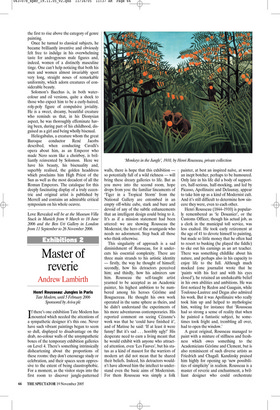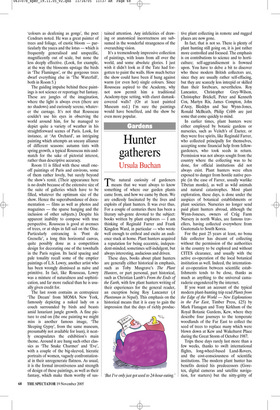Master of reverie
Andrew Lambirth
Henri Rousseau: Jungles in Paris Tate Modern, until 5 February 2006 Sponsored by Aviva plc If there’s one exhibition Tate Modern has mounted which needed the attentions of a sympathetic designer it’s this one. Never have such vibrant paintings begun to seem so dull, displayed to disadvantage on the drab, no-colour walls of the unsympathetic boxes of the temporary exhibition galleries on Level 4. There’s something intrinsically disheartening about the proportions of these rooms: they don’t encourage study or celebration, and their spaces seem oppressive to the extent of being claustrophobic. For a moment, as the visitor steps into the first room to discover jungle-patterned walls, there is hope that this exhibition so potentially full of a wild richness — will bring these dreary galleries to life. But as you move into the second room, hope drops from you: the familiar lineaments of ‘Tiger in a Tropical Storm’ from the National Gallery are entombed in an empty off-white cube, stark and bare and devoid of any of the subtle enhancements that an intelligent design could bring to it. It’s as if a mission statement had been uttered: we are showing Rousseau the Modernist, the hero of the avantgarde who needs no adornment. Step back all those who think otherwise.
This singularity of approach is a sad diminishment of Rousseau, for it undercuts his essential complexity. There are three main strands to his artistic identity — firstly, the way he thought of himself; secondly, how his detractors perceived him; and thirdly, how his admirers saw him. Rousseau the self-taught artist yearned to be accepted as an Academic painter, his highest ambition to be numbered among his heroes Gér6me and Bouguereau. He thought his own work operated in the same sphere as theirs, and he didn’t understand the experiments of his more adventurous contemporaries. His reported comment on seeing Cézanne’s work was that he ‘could have finished it’, and of Matisse he said: ‘If at least it were funny! But it’s sad ... horribly ugly!’ His desperate need to earn a living meant that he would exhibit with anyone who attracted attention, even ‘Les Fauves’, but his status as a kind of mascot for the warriors of modern art did not mean that he shared their beliefs. Indeed, his detractors wouldn’t have allowed him the intellect to understand even the basic aims of Modernism. For them Rousseau was simply a folk painter, at best an inspired naïve, at worst an inept botcher, perhaps to be humoured. Only late in his life did a body of supporters, half-serious, half-mocking, and led by Picasso, Apollinaire and Delaunay, appear to take him up as a kind of Modernist cult. And it’s still difficult to determine how sincere they were, even to each other.
Henri Rousseau (1844–1910) is popularly remembered as ‘le Douanier’, or the Customs Officer, though his actual job, as a clerk in the municipal toll service, was less exalted. He took early retirement at the age of 41 to devote himself to painting, but made so little money that he often had to resort to busking (he played the fiddle) to eke out his earnings as an art teacher. There was something childlike about his nature, and perhaps also in his capacity to enjoy life to the full. Although much mocked (one journalist wrote that he ‘paints with his feet and with his eyes closed’), he retained an unshakeable belief in his own abilities and ambitions. He was first noticed by Redon and Gauguin, while Toulouse-Lautrec and Degas also admired his work. But it was Apollinaire who really took him up and helped to mythologise him, writing for instance that ‘Rousseau had so strong a sense of reality that when he painted a fantastic subject, he sometimes took fright and, trembling all over, had to open the window.’ A great original, Rousseau managed to paint with a mixture of stiffness and freshness which owes something to the Academicians Gér6me and Clement, but is also reminiscent of such diverse artists as Friedrich and Chagall. Kandinsky praised him highly for opening up ‘new possibilities of simplicity’ in realism. Rousseau is a master of reverie and enchantment, a brilliant designer who could orchestrate ‘colours as deafening as gongs’, the poet Cendrars noted. He was a great painter of trees and foliage, of exotic bloom — particularly the yucca and the lotus — which is frequently generalised and unspecific, magnificently out of scale, but none the less deeply effective. (Look, for example, at the way the blossoms upstage the birds in ‘The Flamingos’, or the gorgeous trees dwarf everything else in ‘The Waterfall’, both in Room 5.) The guiding impulse behind these paintings is not science or reportage but fantasy. These are jungles of the imagination, where the light is always even (there are no shadows) and curiously serene, whatever the carnage. It’s not that Rousseau couldn’t use his eyes in observing the world around him, for he managed to depict quite a variety of weather in his straightforward scenes of Paris. Look, for instance, at ‘An Orchard’, an intriguing painting which attempts an uneasy alliance of different seasons: autumn tints with spring growth, a typical Rousseau mix-andmatch for the sake of pictorial interest, rather than descriptive accuracy.
Room 11 is filled with these small oneoff paintings of Paris and environs, some of them rather lovely, but surely beyond the show’s remit. (Their appearance here is no doubt because of the extensive size of the suite of galleries which have to be filled, whatever the optimum size of the show. Hence the superabundance of documentation — films as well as photos and magazines — the sparse hanging and the inclusion of other subjects.) Despite his apparent inability to compose with true perspective, Rousseau is good at avenues of trees, or at ships in full sail on the Oise. Particularly entrancing is ‘Pont de Grenelle’, a long thin horizontal canvas, quite possibly done as a competition design for decorating one of the townhalls in the Paris region. Its lucid spacing and pale tonality recall some of the emptier paintings of L.S. Lowry, another artist who has been wrongly dismissed as naïve and primitive. In fact, like Rousseau, Lowry was a mixture of naturalness and sophistication, and far more radical than he is usually given credit for.
The last room contains as centrepiece ‘The Dream’ from MOMA New York, famously depicting a naked lady on a couch surrounded by birds and beasts amid luxuriant jungle growth. A fine picture to end on (the one painting we might miss is another famous image, ‘The Sleeping Gypsy’, from the same museum, presumably not available for loan), it neatly encapsulates the exhibition’s main theme. Around it are hung such other classics as ‘The Snake Charmer’ and ‘Eve’, with a couple of the big-sleeved, hieratic portraits of women, vaguely confrontational in their unregenerate flatness. As usual, it is the formal inventiveness and strength of design of these paintings, as well as their fantasy, which make them worthy of sus tained attention. Any infelicities of drawing or anatomical incorrectness are subsumed in the wonderful strangeness of the overarching vision.
It’s a tremendously impressive collection of paintings, with loans from all over the world, and some absolute glories. I just wish it didn’t look as if the Tate had forgotten to paint the walls. How much better the show could have been if hung against warm (or even hot) single colours. Since Rousseau aspired to the Academy, why not now permit him a traditional Academy-type setting, with claret damaskcovered walls? (Or at least painted Museum red.) I’m sure the paintings would have benefited, and the show be even more popular.


























































 Previous page
Previous page